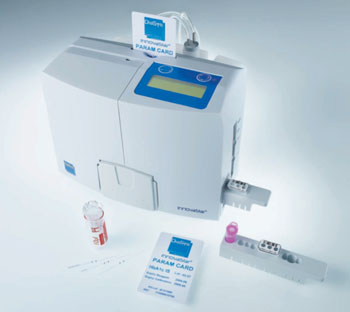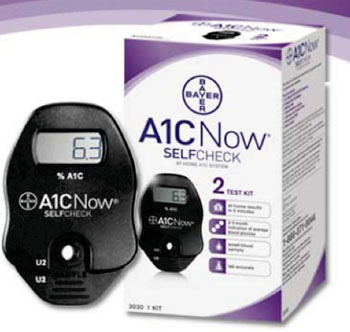Routine Blood Glucose Measurements Can Accurately Estimate HbA1c
|
By LabMedica International staff writers Posted on 06 May 2014 |

Image: A typical clinical laboratory diabetes analyzer (Photo courtesy of Innovastar).

Image: The A1CNow monitoring system for glycated hemoglobin (HbA1c) levels (Photo courtesy of Bayer).
Glycated hemoglobin or HbA1c is the standard measurement for assessing glycemic control over time in people with diabetes and blood levels of HbA1c are typically measured every few months in a laboratory.
The relationship between HbA1c and average glucose levels could determine whether HbA1c could be expressed and reported as average glucose in the same units as used in self-monitoring which could increase individuals' motivation to improve diabetes control.
Scientists at the University of Virginia (Charlottesville, VA, USA) working with those at Sanofi-Aventis Deutschland GmbH (Frankfurt, Germany) developed a data-based model that accurately estimates HbA1c using self-monitored blood glucose (SMBG) readings. The computer algorithm they developed was based on a training data set drawn from 379 subjects and then evaluated for accuracy on an independent test data set. The average HbA1c level was 7.6% (± 1.1%), with minimum and maximum values of 5.2% and 12.2%, respectively.
A conceptually new, clinically viable procedure was developed for real-time tracking of average glycaemia from self-monitoring data. The average glucose tracing can then be converted into running estimates of HbA1c, which can be presented to the patient daily. The computational demands of the procedure are low and therefore readily implementable into devices with limited processing power, such as home SMBG meter.
The procedure, tracking average glycaemia and HbA1c in real time, could provide valuable assistance to the daily optimization of diabetes control. The procedure is not intended as a substitute for laboratory assessments of HbA1c and it should be viewed as a surrogate measure that allows convenient tracing of average glucose, readily implementable in a point-of-care SMBG device.
Satish Garg, MD, a professor of medicine and pediatrics at the University of Colorado (Denver, CO, USA) said, “Patients are used to a HbA1c result from their doctor visits, and this study highlights simple estimated HbA1c values from SMBG data. This may become an important tool for improved patient self-management.” The study was published on April 23, 2014, in the journal Diabetes Technology & Therapeutics.
Related Links:
University of Virginia
Sanofi-Aventis Deutschland GmbH
University of Colorado
The relationship between HbA1c and average glucose levels could determine whether HbA1c could be expressed and reported as average glucose in the same units as used in self-monitoring which could increase individuals' motivation to improve diabetes control.
Scientists at the University of Virginia (Charlottesville, VA, USA) working with those at Sanofi-Aventis Deutschland GmbH (Frankfurt, Germany) developed a data-based model that accurately estimates HbA1c using self-monitored blood glucose (SMBG) readings. The computer algorithm they developed was based on a training data set drawn from 379 subjects and then evaluated for accuracy on an independent test data set. The average HbA1c level was 7.6% (± 1.1%), with minimum and maximum values of 5.2% and 12.2%, respectively.
A conceptually new, clinically viable procedure was developed for real-time tracking of average glycaemia from self-monitoring data. The average glucose tracing can then be converted into running estimates of HbA1c, which can be presented to the patient daily. The computational demands of the procedure are low and therefore readily implementable into devices with limited processing power, such as home SMBG meter.
The procedure, tracking average glycaemia and HbA1c in real time, could provide valuable assistance to the daily optimization of diabetes control. The procedure is not intended as a substitute for laboratory assessments of HbA1c and it should be viewed as a surrogate measure that allows convenient tracing of average glucose, readily implementable in a point-of-care SMBG device.
Satish Garg, MD, a professor of medicine and pediatrics at the University of Colorado (Denver, CO, USA) said, “Patients are used to a HbA1c result from their doctor visits, and this study highlights simple estimated HbA1c values from SMBG data. This may become an important tool for improved patient self-management.” The study was published on April 23, 2014, in the journal Diabetes Technology & Therapeutics.
Related Links:
University of Virginia
Sanofi-Aventis Deutschland GmbH
University of Colorado
Latest Clinical Chem. News
- Carbon Nanotubes Help Build Highly Accurate Sensors for Continuous Health Monitoring
- Paper-Based Device Boosts HIV Test Accuracy from Dried Blood Samples
- AI-Powered Raman Spectroscopy Method Enables Rapid Drug Detection in Blood
- Novel LC-MS/MS Assay Detects Low Creatinine in Sweat and Saliva
- Biosensing Technology Breakthrough Paves Way for New Methods of Early Disease Detection
- New Saliva Test Rapidly Identifies Paracetamol Overdose
- POC Saliva Testing Device Predicts Heart Failure in 15 Minutes

- Screening Tool Detects Multiple Health Conditions from Single Blood Drop
- Integrated Chemistry and Immunoassay Analyzer with Extensive Assay Menu Offers Flexibility, Scalability and Data Commutability
- Rapid Drug Test to Improve Treatment for Patients Presenting to Hospital
- AI Model Detects Cancer at Lightning Speed through Sugar Analyses
- First-Ever Blood-Powered Chip Offers Real-Time Health Monitoring
- New ADLM Guidance Provides Expert Recommendations on Clinical Testing For Respiratory Viral Infections
- 3D Printed Point-Of-Care Mass Spectrometer Outperforms State-Of-The-Art Models
- POC Biomedical Test Spins Water Droplet Using Sound Waves for Cancer Detection
- Highly Reliable Cell-Based Assay Enables Accurate Diagnosis of Endocrine Diseases
Channels
Molecular Diagnostics
view channel
D-Dimer Testing Can Identify Patients at Higher Risk of Pulmonary Embolism
Pulmonary embolism (PE) is a commonly suspected condition in emergency departments (EDs) and can be life-threatening if not diagnosed correctly. Achieving an accurate diagnosis is vital for providing effective... Read more
New Biomarkers to Improve Early Detection and Monitoring of Kidney Injury
Drug-induced kidney injury, also known as nephrotoxicity, is a prevalent issue in clinical practice, occurring when specific medications at certain doses cause damage to the kidneys. Nephrotoxicity can... Read moreHematology
view channel
New Scoring System Predicts Risk of Developing Cancer from Common Blood Disorder
Clonal cytopenia of undetermined significance (CCUS) is a blood disorder commonly found in older adults, characterized by mutations in blood cells and a low blood count, but without any obvious cause or... Read more
Non-Invasive Prenatal Test for Fetal RhD Status Demonstrates 100% Accuracy
In the United States, approximately 15% of pregnant individuals are RhD-negative. However, in about 40% of these cases, the fetus is also RhD-negative, making the administration of RhoGAM unnecessary.... Read moreImmunology
view channel
Post-Treatment Blood Test Could Inform Future Cancer Therapy Decisions
In the ongoing advancement of personalized medicine, a new study has provided evidence supporting the use of a tool that detects cancer-derived molecules in the blood of lung cancer patients years after... Read more
Cerebrospinal Fluid Test Predicts Dangerous Side Effect of Cancer Treatment
In recent years, cancer immunotherapy has emerged as a promising approach where the patient's immune system is harnessed to fight cancer. One form of immunotherapy, called CAR-T-cell therapy, involves... Read more
New Test Measures Preterm Infant Immunity Using Only Two Drops of Blood
Preterm infants are particularly vulnerable due to their organs still undergoing development, which can lead to difficulties in breathing, eating, and regulating body temperature. This is especially true... Read more
Simple Blood Test Could Help Choose Better Treatments for Patients with Recurrent Endometrial Cancer
Endometrial cancer, which develops in the lining of the uterus, is the most prevalent gynecologic cancer in the United States, affecting over 66,000 women annually. Projections indicate that in 2025, around... Read moreMicrobiology
view channel
Breakthrough Diagnostic Technology Identifies Bacterial Infections with Almost 100% Accuracy within Three Hours
Rapid and precise identification of pathogenic microbes in patient samples is essential for the effective treatment of acute infectious diseases, such as sepsis. The fluorescence in situ hybridization... Read more
Innovative ID/AST System to Help Diagnose Infectious Diseases and Combat AMR
Each year, 11 million people across the world die of sepsis out of which 1.3 million deaths are due to antibiotic-resistant bacteria. The burden of antimicrobial resistance (AMR) continues to weigh heavily,... Read more
Gastrointestinal Panel Delivers Rapid Detection of Five Common Bacterial Pathogens for Outpatient Use
Acute infectious gastroenteritis results in approximately 179 million cases each year in the United States, leading to a significant number of outpatient visits and hospitalizations. To address this, a... Read morePathology
view channel
AI Model Predicts Patient Response to Bladder Cancer Treatment
Each year in the United States, around 81,000 new cases of bladder cancer are diagnosed, leading to approximately 17,000 deaths annually. Muscle-invasive bladder cancer (MIBC) is a severe form of bladder... Read more
New Laser-Based Method to Accelerate Cancer Diagnosis
Researchers have developed a method to improve cancer diagnostics and other diseases. Collagen, a key structural protein, plays various roles in cell activity. A novel multidisciplinary study published... Read more
New AI Model Predicts Gene Variants’ Effects on Specific Diseases
In recent years, artificial intelligence (AI) has greatly enhanced our ability to identify a vast number of genetic variants in increasingly larger populations. However, up to half of these variants are... Read more
Powerful AI Tool Diagnoses Coeliac Disease from Biopsy Images with Over 97% Accuracy
Coeliac disease is an autoimmune disorder triggered by the consumption of gluten, causing symptoms such as stomach cramps, diarrhea, skin rashes, weight loss, fatigue, and anemia. Due to the wide variation... Read moreTechnology
view channel
Smartphones Could Diagnose Diseases Using Infrared Scans
Rapid advancements in technology may soon make it possible for individuals to bypass invasive medical procedures by simply uploading a screenshot of their lab results from their phone directly to their doctor.... Read more
Novel Sensor Technology to Enable Early Diagnoses of Metabolic and Cardiovascular Disorders
Metabolites are critical compounds that fuel life's essential functions, playing a key role in producing energy, regulating cellular activities, and maintaining the balance of bodily systems.... Read more
3D Printing Breakthrough Enables Large Scale Development of Tiny Microfluidic Devices
Microfluidic devices are diagnostic systems capable of analyzing small volumes of materials with precision and speed. These devices are used in a variety of applications, including cancer cell analysis,... Read moreIndustry
view channel



















